fuel type HONDA CIVIC HYBRID 2013 9.G Owners Manual
[x] Cancel search | Manufacturer: HONDA, Model Year: 2013, Model line: CIVIC HYBRID, Model: HONDA CIVIC HYBRID 2013 9.GPages: 346, PDF Size: 6.95 MB
Page 253 of 346
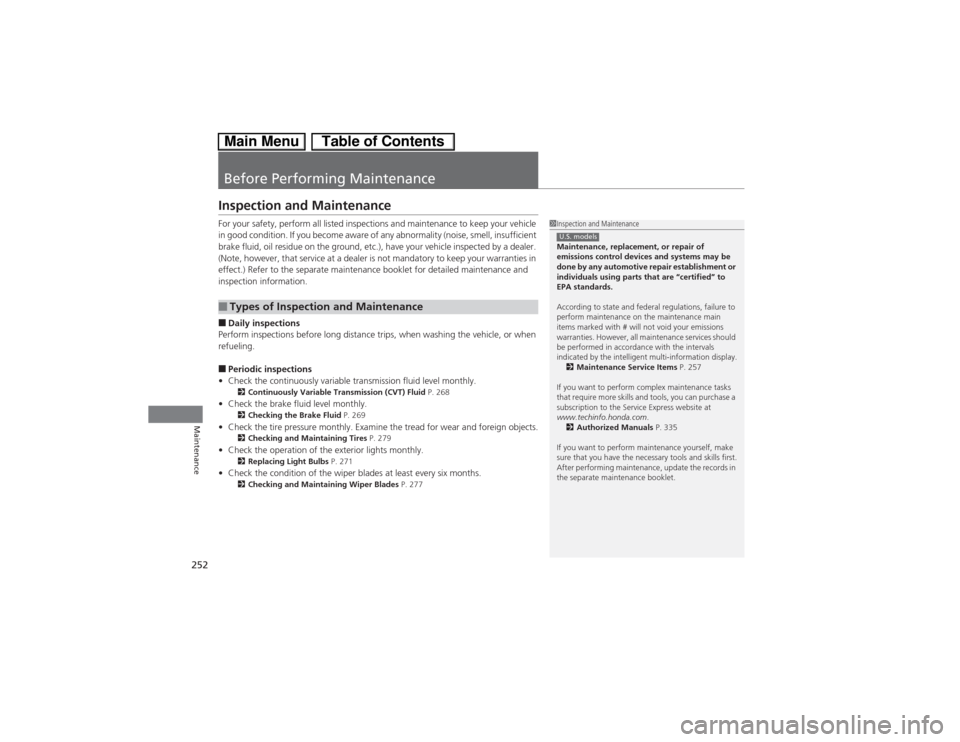
252Maintenance
Before Performing MaintenanceInspection and MaintenanceFor your safety, perform all listed inspections and maintenance to keep your vehicle
in good condition. If you become aware of any abnormality (noise, smell, insufficient
brake fluid, oil residue on the ground, etc.), have your vehicle inspected by a dealer.
(Note, however, that service at a dealer is not mandatory to keep your warranties in
effect.) Refer to the separate maintenance booklet for detailed maintenance and
inspection information.■Daily inspections
Perform inspections before long distance trips, when washing the vehicle, or when
refueling.■Periodic inspections
•Check the continuously variable transmission fluid level monthly.2Continuously Variable Transmission (CVT) Fluid P. 268
•Check the brake fluid level monthly.
2Checking the Brake Fluid P. 269
•Check the tire pressure monthly. Examine the tread for wear and foreign objects.
2Checking and Maintaining Tires P. 279
•Check the operation of the exterior lights monthly.
2Replacing Light Bulbs P. 271
•Check the condition of the wiper blades at least every six months.
2Checking and Maintaining Wiper Blades P. 277
■Types of Inspection and Maintenance
1Inspection and Maintenance
Maintenance, replacement, or repair of
emissions control devices and systems may be
done by any automotive repair establishment or
individuals using parts that are “certified” to
EPA standards.
According to state and federal regulations, failure to
perform maintenance on the maintenance main
items marked with # will not void your emissions
warranties. However, all maintenance services should
be performed in accordance with the intervals
indicated by the intelligent multi-information display.
2Maintenance Service Items P. 257
If you want to perform complex maintenance tasks
that require more skills and tools, you can purchase a
subscription to the Service Express website at
www.techinfo.honda.com.
2Authorized Manuals P. 335
If you want to perform maintenance yourself, make
sure that you have the necessary tools and skills first.
After performing maintenance, update the records in
the separate maintenance booklet.U.S. models
Page 267 of 346
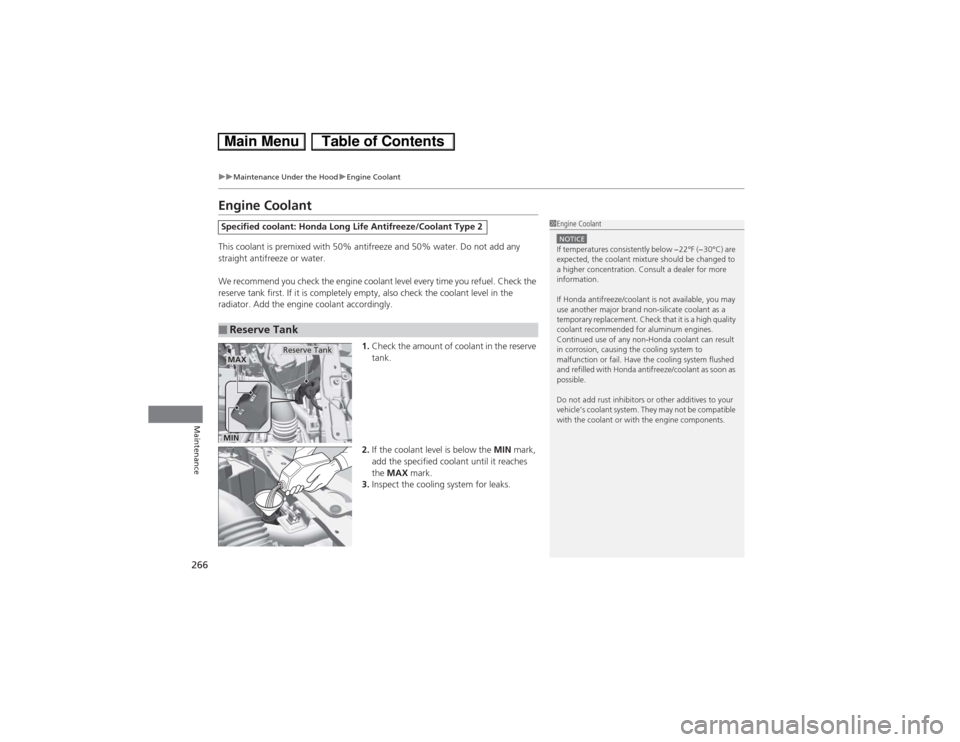
266
uuMaintenance Under the HooduEngine Coolant
Maintenance
Engine CoolantThis coolant is premixed with 50% antifreeze and 50% water. Do not add any
straight antifreeze or water.
We recommend you check the engine coolant level every time you refuel. Check the
reserve tank first. If it is completely empty, also check the coolant level in the
radiator. Add the engine coolant accordingly.
1.Check the amount of coolant in the reserve
tank.
2.If the coolant level is below the MIN mark,
add the specified coolant until it reaches
the MAX mark.
3.Inspect the cooling system for leaks.Specified coolant: Honda Long Life Antifreeze/Coolant Type 2■Reserve Tank
1Engine CoolantNOTICEIf temperatures consistently below −22°F (−30°C) are
expected, the coolant mixture should be changed to
a higher concentration. Consult a dealer for more
information.
If Honda antifreeze/coolant is not available, you may
use another major brand non-silicate coolant as a
temporary replacement. Check that it is a high quality
coolant recommended for aluminum engines.
Continued use of any non-Honda coolant can result
in corrosion, causing the cooling system to
malfunction or fail. Have the cooling system flushed
and refilled with Honda antifreeze/coolant as soon as
possible.
Do not add rust inhibitors or other additives to your
vehicle’s coolant system. They may not be compatible
with the coolant or with the engine components.
Reserve Tank
MAXMIN
Page 280 of 346
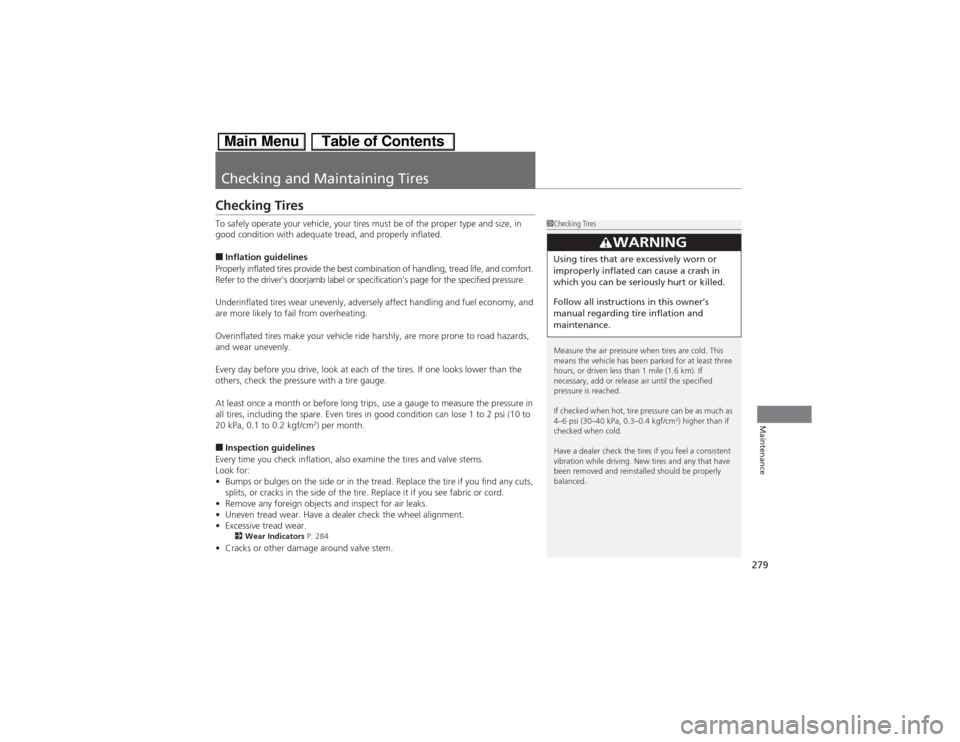
279Maintenance
Checking and Maintaining TiresChecking TiresTo safely operate your vehicle, your tires must be of the proper type and size, in
good condition with adequate tread, and properly inflated.■Inflation guidelines
Properly inflated tires provide the best combination of handling, tread life, and comfort.
Refer to the driver’s doorjamb label or specification’s page for the specified pressure.
Underinflated tires wear unevenly, adversely affect handling and fuel economy, and
are more likely to fail from overheating.
Overinflated tires make your vehicle ride harshly, are more prone to road hazards,
and wear unevenly.
Every day before you drive, look at each of the tires. If one looks lower than the
others, check the pressure with a tire gauge.
At least once a month or before long trips, use a gauge to measure the pressure in
all tires, including the spare. Even tires in good condition can lose 1 to 2 psi (10 to
20 kPa, 0.1 to 0.2 kgf/cm
2) per month.
■Inspection guidelines
Every time you check inflation, also examine the tires and valve stems.
Look for:
•Bumps or bulges on the side or in the tread. Replace the tire if you find any cuts,
splits, or cracks in the side of the tire. Replace it if you see fabric or cord.
•Remove any foreign objects and inspect for air leaks.
•Uneven tread wear. Have a dealer check the wheel alignment.
•Excessive tread wear.2Wear Indicators P. 284
•Cracks or other damage around valve stem.
1Checking Tires
Measure the air pressure when tires are cold. This
means the vehicle has been parked for at least three
hours, or driven less than 1 mile (1.6 km). If
necessary, add or release air until the specified
pressure is reached.
If checked when hot, tire pressure can be as much as
4–6 psi (30–40 kPa, 0.3–0.4 kgf/cm
2) higher than if
checked when cold.
Have a dealer check the tires if you feel a consistent
vibration while driving. New tires and any that have
been removed and reinstalled should be properly
balanced.
3
WARNING
Using tires that are excessively worn or
improperly inflated can cause a crash in
which you can be seriously hurt or killed.
Follow all instructions in this owner’s
manual regarding tire inflation and
maintenance.
Page 327 of 346
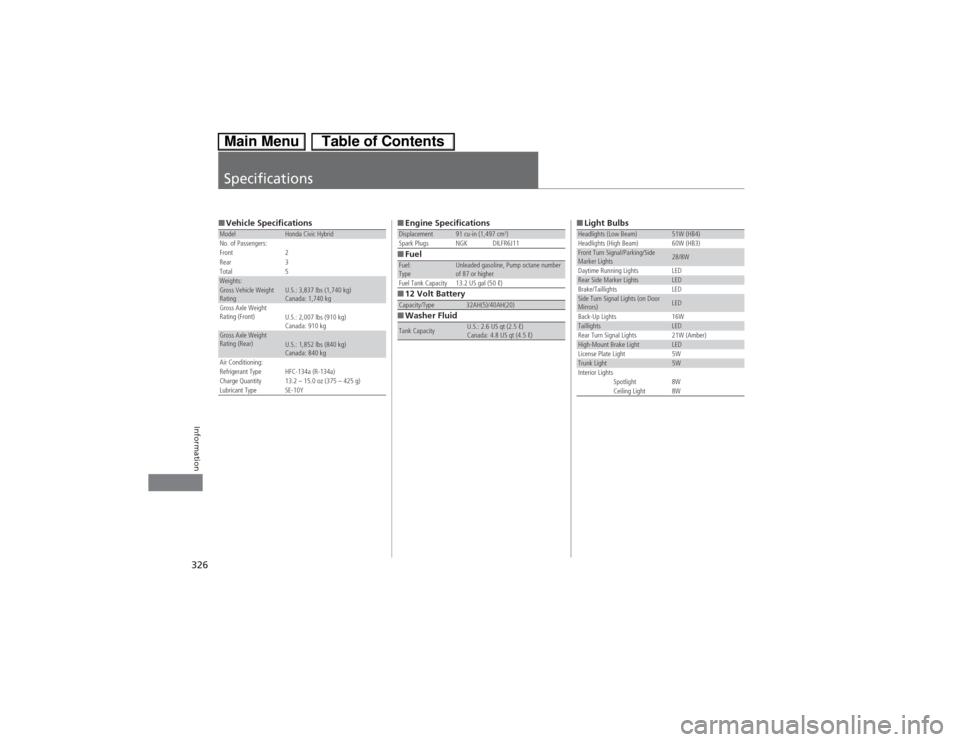
326Information
Specifications■Vehicle SpecificationsModel
Honda Civic Hybrid
No. of Passengers:
Front 2
Rear 3
Total 5
Weights:Gross Vehicle Weight
Rating
U.S.: 3,837 lbs (1,740 kg)
Canada: 1,740 kg
Gross Axle Weight
Rating (Front)
U.S.: 2,007 lbs (910 kg)
Canada: 910 kg
Gross Axle Weight
Rating (Rear)
U.S.: 1,852 lbs (840 kg)
Canada: 840 kg
Air Conditioning:
Refrigerant Type HFC-134a (R-134a)
Charge Quantity 13.2 – 15.0 oz (375 – 425 g)
Lubricant Type SE-10Y
■Engine Specifications
■Fuel
■12 Volt Battery
■Washer FluidDisplacement
91 cu-in (1,497 cm
3)
Spark Plugs NGK DILFR6J11
Fuel:
Type
Unleaded gasoline, Pump octane number
of 87 or higher
Fuel Tank Capacity 13.2 US gal (50 ℓ)
Capacity/Type
32AH(5)/40AH(20)
Tank Capacity
U.S.: 2.6 US qt (2.5 ℓ)
Canada: 4.8 US qt (4.5 ℓ)
■Light BulbsHeadlights (Low Beam)
51W (HB4)
Headlights (High Beam) 60W (HB3)
Front Turn Signal/Parking/Side
Marker Lights
28/8W
Daytime Running Lights LED
Rear Side Marker Lights
LED
Brake/Taillights LED
Side Turn Signal Lights (on Door
Mirrors)
LED
Back-Up Lights 16W
Taillights
LED
Rear Turn Signal Lights 21W (Amber)
High-Mount Brake Light
LED
License Plate Light 5W
Trunk Light
5W
Interior Lights
Spotlight 8W
Ceiling Light 8W
Page 342 of 346
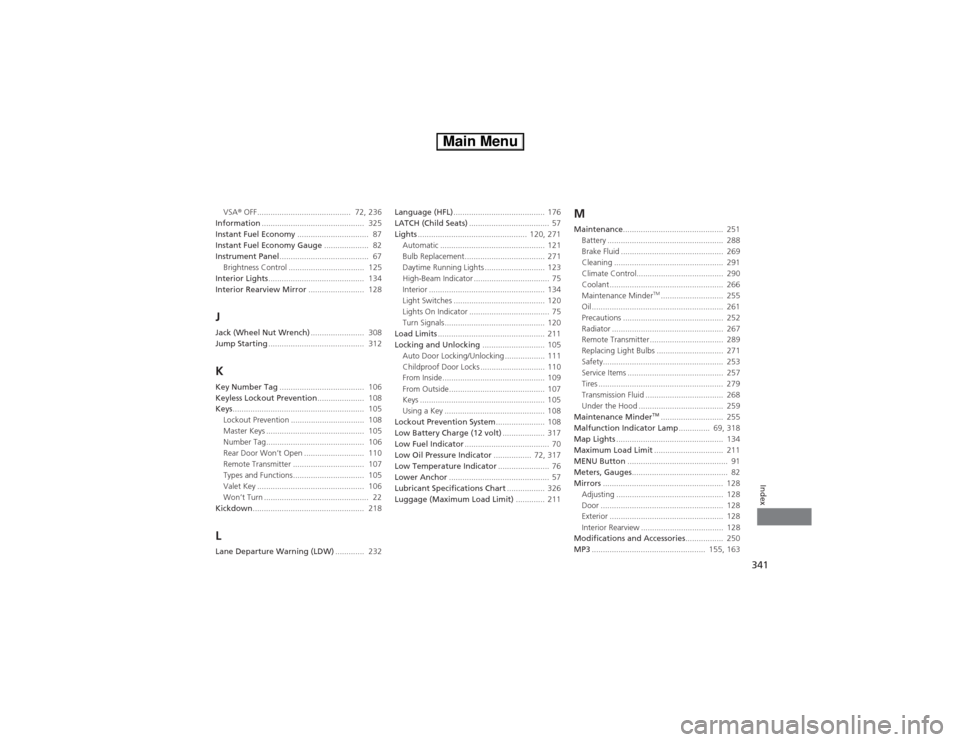
341Index
VSA® OFF.......................................... 72, 236
Information.............................................. 325
Instant Fuel Economy................................ 87
Instant Fuel Economy Gauge.................... 82
Instrument Panel........................................ 67
Brightness Control .................................. 125
Interior Lights........................................... 134
Interior Rearview Mirror......................... 128JJack (Wheel Nut Wrench)........................ 308
Jump Starting........................................... 312KKey Number Tag...................................... 106
Keyless Lockout Prevention..................... 108
Keys........................................................... 105
Lockout Prevention ................................. 108
Master Keys ............................................ 105
Number Tag............................................ 106
Rear Door Won’t Open ........................... 110
Remote Transmitter ................................ 107
Types and Functions................................ 105
Valet Key ................................................ 106
Won’t Turn ............................................... 22
Kickdown.................................................. 218LLane Departure Warning (LDW)............. 232Language (HFL)......................................... 176
LATCH (Child Seats).................................... 57
Lights................................................. 120, 271
Automatic ............................................... 121
Bulb Replacement.................................... 271
Daytime Running Lights ........................... 123
High-Beam Indicator .................................. 75
Interior .................................................... 134
Light Switches ......................................... 120
Lights On Indicator .................................... 75
Turn Signals............................................. 120
Load Limits................................................ 211
Locking and Unlocking............................ 105
Auto Door Locking/Unlocking .................. 111
Childproof Door Locks ............................. 110
From Inside.............................................. 109
From Outside........................................... 107
Keys ........................................................ 105
Using a Key ............................................. 108
Lockout Prevention System...................... 108
Low Battery Charge (12 volt)................... 317
Low Fuel Indicator...................................... 70
Low Oil Pressure Indicator................. 72, 317
Low Temperature Indicator....................... 76
Lower Anchor............................................. 57
Lubricant Specifications Chart................. 326
Luggage (Maximum Load Limit)............. 211
MMaintenance............................................. 251
Battery .................................................... 288
Brake Fluid .............................................. 269
Cleaning ................................................. 291
Climate Control....................................... 290
Coolant ................................................... 266
Maintenance Minder
TM............................ 255
Oil ........................................................... 261
Precautions ............................................. 252
Radiator .................................................. 267
Remote Transmitter ................................. 289
Replacing Light Bulbs .............................. 271
Safety...................................................... 253
Service Items ........................................... 257
Tires ........................................................ 279
Transmission Fluid ................................... 268
Under the Hood ...................................... 259
Maintenance MinderTM............................ 255
Malfunction Indicator Lamp.............. 69, 318
Map Lights................................................ 134
Maximum Load Limit............................... 211
MENU Button............................................. 91
Meters, Gauges........................................... 82
Mirrors...................................................... 128
Adjusting ................................................ 128
Door ....................................................... 128
Exterior ................................................... 128
Interior Rearview ..................................... 128
Modifications and Accessories................. 250
MP3................................................... 155, 163